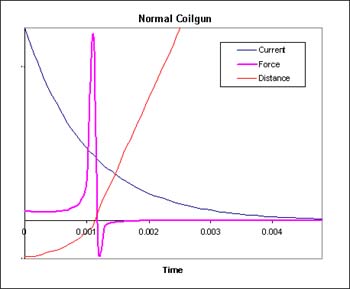 To the right is a figure resulting from the numerical simulation I made with Excel. This figure shows the coil current, acceleration force, and the distance from the projectile to the center of the coil. For this simulation the projectile was assumed to be a point mass and the coil was assumed to be a point charge. Both the x and y axis have arbitrary units, the x axis being time. The coil is assumed to be purely resistive with no inductive qualities. These simulations do not yield quantitative results, but the trends shown should be representative of typical systems.
To the right is a figure resulting from the numerical simulation I made with Excel. This figure shows the coil current, acceleration force, and the distance from the projectile to the center of the coil. For this simulation the projectile was assumed to be a point mass and the coil was assumed to be a point charge. Both the x and y axis have arbitrary units, the x axis being time. The coil is assumed to be purely resistive with no inductive qualities. These simulations do not yield quantitative results, but the trends shown should be representative of typical systems.
At time zero, the capacitor bank is discharged as a large current passes through the coil. This figure shows that the current decays exponentially with time.
Since the force of acceleration is inversely proportional to the square of the distance, the force is really only "active" as the distance nears zero, or the center of the coil. Notice how the best potential acceleration force (when the current is at its peak) is wasted because the projectile is too far away to be affected optimally. To utilize this peak current and force, the projectile can be initially placed closer to the center of the coil, but doing so increases the suck-back effect.
The figure shows an inflection point in the force curve as the projectile passes through the center of the coil where the projectile now begins to experience "suck-back" or a force in the decelerating direction. The amount of suck-back is the portion of the force curve that dips below zero, essentially everything after the projectile passes the center of the coil. Since the area of forward acceleration force (above zero on the y axis) is greater than the area of suck-back acceleration, the net acceleration is forward and the projectile rockets out of the gun.
The slope of the "distance" curve is the velocity of the projectile. After the projectile leaves the coil and is far enough from the dissipating electromagnetic field, its velocity is constant as it travels through the rest of the barrel.
In order to optimize this type of accelerator, care must be taken to determine the best starting position. The starting position must maximize the most peak acceleration force (by starting the projectile closer to the center of the coil) but also minimize the suck-back force (by moving the projectile further from the center of the coil). Tricky business! With such a design, acceleration and efficiency will always suffer greatly.
 The figure to the right shows a simulation in which a magnetic projectile utilizing a repulsive type acceleration system is used. Again the current curve decays exponentially with time as before.
It is easy to see that there are significant differences in the profiles of the distance and force curves.
The figure to the right shows a simulation in which a magnetic projectile utilizing a repulsive type acceleration system is used. Again the current curve decays exponentially with time as before.
It is easy to see that there are significant differences in the profiles of the distance and force curves.